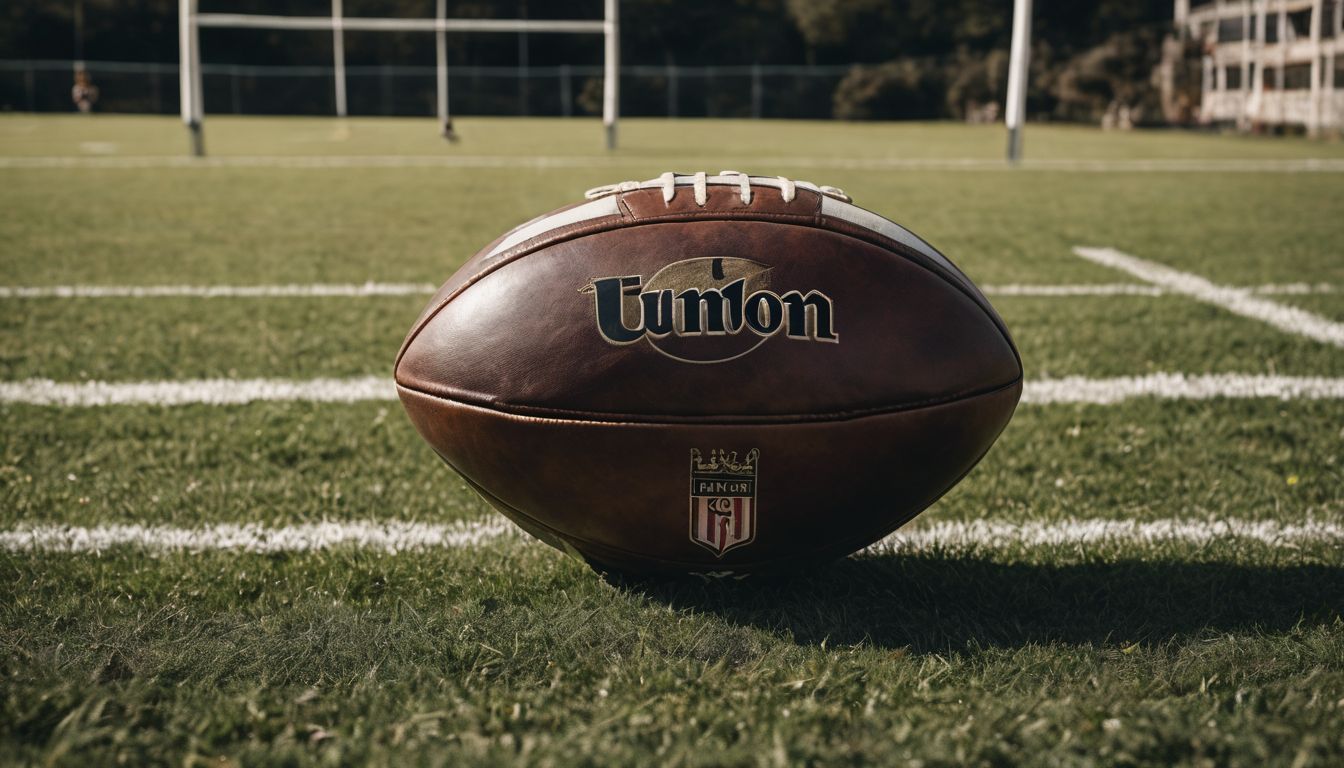As rugby fans, we’ve all winced at the hard hits and injuries players endure on the pitch. Since rugby union turned professional in 1995, there’s been a noticeable rise in these injuries.
This blog will delve into this shift, revealing what increased professionalism means for player safety and the game’s future. Read on to uncover how this change has reshaped rugby union.
Key Takeaways
- Rugby union turned professional in 1995, leading to increased commercialisation and sponsorship deals, which changed the game’s culture and training approaches.
- Since becoming a professional sport, rugby has seen a rise in player injuries due to the more competitive nature of the game and commercial pressures to perform at high levels.
- Common injuries now include concussions, ligament sprains, fractures, dislocations, and contusions; these often affect players’ heads, necks, shoulders, knees, lower limbs and back.
- The frequency and severity of injuries are higher in professional rugby than in amateur rugby because of better-funded clubs that demand peak performances from players regularly.
- Ensuring player safety while balancing commercial interests is vital for the future sustainability of professional rugby; this includes focusing on injury prevention strategies to protect athletes.
History of Professionalism in Rugby Union
Rugby union took a monumental leap in 1995, shifting from an amateur to a professional sport. This change followed years of heated debate and under-the-table payments that suggested many players were already effectively professional in all but name.
Eyes across the world turned to Europe as leagues there transitioned, redefining rugby culture. The game’s very fabric changed overnight; teams quickly began adopting more professional approaches, with rigorous training regimens and strategic plays becoming the norm.
The commercialisation of rugby brought about significant developments at both club and international levels. Sponsorship deals flourished, leading to well-funded clubs who could afford better facilities and attract top talent from around the globe.
European rugby witnessed substantial growth—the Six Nations Championship grew in prestige while domestic leagues like England’s Premiership Rugby expanded their reach extensively.
Coaches focused increasingly on creating undefeated squads capable of capturing titles which intensified competition across this newly professional landscape.
Increase in Injuries Since Professionalism
The shift towards professionalism in rugby union has led to a significant increase in injuries among players. This can be attributed to the impact of commercialisation, increased emphasis on winning, and the pressure to perform at a higher level.
Impact of commercialisation
Commercialisation of rugby union has brought about a significant shift in the approach to the sport, with a pronounced emphasis on winning and financial gains. This increased focus on commercial success has led to greater pressure on players to perform at their peak in competitive matches.
The introduction of professionalism has also seen a surge in injuries, affecting both professional and amateur players due to the higher intensity and physical demands of the game.
Professionalism’s impact on rugby union is evident through its transformation into a more commercially driven sport, highlighting the need for player safety measures amidst an environment that prioritises financial gains over player welfare.
Increased emphasis on winning
The increased emphasis on winning in professional rugby union has driven a shift towards a more competitive and high-stakes environment. This heightened focus on securing victories has intensified the pressure on players to perform at their best, pushing them to physical limits that can contribute to an increase in injuries.
The drive for success within the commercialised landscape of professional rugby has led to a highly demanding and aggressive approach to the sport, impacting both player welfare and the nature of gameplay itself.
With an increased investment in winning as a primary goal, professional rugby union has seen a rise in intense physical competition alongside strategic shifts aimed at achieving victory.
Pressure to perform
With the increased emphasis on winning in professional rugby union, players face heightened pressure to perform at their best in every match. The commercialisation of the sport has elevated expectations for success, leading to a demanding environment where athletes are under constant scrutiny.
As the stakes continue to rise, the pressure to excel and deliver results places significant mental and physical strain on rugby players.
The competitive nature of professional rugby union demands consistent high-level performances from players. This pressure often extends beyond match days, impacting training sessions, recovery periods, and overall player well-being.
Nature of Injuries in Professional Rugby Union
Professional rugby union players are prone to a variety of injuries such as concussions, muscle strains, and ligament tears, often affecting the head, neck, shoulders, and knees. To learn more about the impact of these injuries on the game and players’ welfare in professional rugby union, keep reading.
Type of injuries
The nature of injuries in professional rugby union has evolved since the introduction of professionalism, impacting both players and the game itself. Here are the types commonly seen in professional rugby union:
- Concussions: Head injuries are prevalent due to the physical nature of the sport, leading to concerns about player welfare.
- Ligament Sprains: Knee and ankle sprains are frequent due to sudden directional changes and impacts during matches.
- Fractures: Commonly occurring in limbs and facial bones due to collisions and tackles during gameplay.
- Dislocations: Shoulder dislocations are common, often resulting from aggressive tackles or scrums.
- Contusions: Bruising is frequently observed, mainly on the thighs and upper body areas from physical contact.
Commonly affected body parts
Since the introduction of professionalism in rugby union, players have experienced an increase in injuries affecting various body parts. Here are the commonly affected body parts:
- Head and Neck: Injuries to the head and neck, including concussions and neck strains, are prevalent due to the physical nature of the sport.
- Shoulders: Rugby players often suffer from shoulder dislocations, rotator cuff injuries, and acromioclavicular joint sprains during tackles and scrums.
- Knees: Ligament tears such as ACL injuries and meniscus tears are common due to sudden changes in direction and impact during gameplay.
- Lower Limbs: Players frequently experience ankle sprains, muscle strains, and Achilles tendon injuries while running and tackling.
- Hands and Fingers: Fractures, dislocations, and lacerations in hands and fingers result from grappling for possession or contact with opponents.
- Ribs and Chest: Impact injuries can lead to rib fractures or contusions in the chest area due to collisions or tackles.
- Spine: Spinal injuries, including fractures or disc herniation, can occur during scrummaging or high-impact collisions on the field.
Severity of injuries
Since professionalism was introduced in rugby union, the severity of injuries has become a growing concern. Here are some key points to consider:
- Injuries are becoming more severe due to the increased physicality and intensity of professional rugby matches.
- Serious injuries such as fractures, concussions, and ligament tears have become more prevalent in professional rugby union.
- The severity of injuries is impacting player welfare and career longevity, leading to longer recovery times and potential long-term health implications.
- The need for better injury prevention strategies has become crucial in mitigating the severity of injuries in professional rugby union.
- High – profile cases of severe injuries have brought about a heightened awareness of the risks involved in professional rugby, prompting discussions on player safety and welfare.
- The severity of injuries is a critical aspect that needs to be addressed to ensure the sustainability and well-being of players in professional rugby union.
Comparison of Injuries between Amateur and Professional Rugby Union
Diving into the comparison of injuries between amateur and professional rugby union unveils some stark contrasts. Here’s an insightful look into how these two levels differ when it comes to injuries sustained on the field.
| Aspect | Amateur Rugby Union | Professional Rugby Union |
|---|---|---|
| Frequency of Injuries | Lower frequency than professional level. | Increased frequency, more matches, and training. |
| Type of Injuries | Often less severe, can include sprains and fractures. | More severe due to higher intensity, includes concussions and ligament tears. |
| Commonly Affected Body Parts | Varies, but less likely to be recurrent. | Often involves shoulders, knees, and head. |
| Severity of Injuries | Generally mild to moderate. | Greater severity, potential for chronic issues. |
| Impact on Career | Less career impact, due to lower stakes. | Significant career implications, due to professional stakes. |
| Commercialisation & Pressure | Lower commercial pressure. | High commercial pressure influences injury management. |
| Prevention and Management | Less access to advanced preventative measures. | Better resources for injury prevention and rehabilitation. |
Analysis of the Impact of Professionalism on Rugby Union
The impact of professionalism on rugby union has led to a significant increase in injuries, with the commercialisation and emphasis on winning contributing to the pressure on players to perform.
This has highlighted the need for injury prevention measures and advocacy for player safety while balancing the demands of commercialisation in the sport.
Need for injury prevention
Professionalism in rugby union has undeniably led to a surge in injuries among players. The impact of commercialisation and the heightened pressure to win have contributed to this rise, thus necessitating a strong focus on injury prevention strategies.
Advocating for player safety and finding ways to balance player welfare with the demands of commercialisation is essential within professional rugby union. This requires a concerted effort from all stakeholders involved, including club management, coaches, medical staff, and governing bodies.
The nature of injuries in rugby has evolved significantly since professionalism was introduced in 1995. With higher injury rates compared to amateur play and an increasing emphasis on winning at all costs, it is crucial to prioritise injury prevention methods that consider the well-being of players without compromising the competitiveness of the sport.
Advocating for player safety
Emphasising player safety is crucial in professional rugby union due to the increased risk of injuries since the sport turned professional in 1995. The commercialisation and heightened focus on winning have contributed to a more intense and physical style of play, leading to a higher frequency of injuries.
As a result, there is a growing need for ongoing analysis and attention to address this concern by advocating for comprehensive injury prevention measures. This approach will help ensure the welfare of players while also balancing the demands of commercialisation within the sport.
Balancing player welfare with commercial pressures has become imperative as professionalism continues to impact European rugby union significantly. The nature and severity of injuries have evolved, demanding careful consideration in order to maintain player safety amidst an increasingly competitive environment.
Balancing player welfare with commercialisation
Advocating for player safety informs the imperative task of balancing player welfare with commercialisation. This crucial balance requires a thoughtful approach to ensure that players’ well-being is not compromised amidst the commercial demands of professional rugby union.
It necessitates implementing measures and regulations that prioritise injury prevention, access to quality medical care, and sufficient rest for players while also acknowledging the financial aspects and competitive pressures within the sport.
Striking this equilibrium involves maintaining a delicate line between promoting the commercial success of rugby union and safeguarding the physical and mental health of its athletes.
Conclusion
In conclusion, professionalism in rugby union has brought about a surge in injuries for both professional and amateur players. Commercialisation of the sport has intensified the pressure to win, leading to an increase in injury frequency and severity.
It is crucial to prioritise player safety while also balancing the demands of commercialisation within professional rugby union. The impact of professionalism on injuries in rugby union requires ongoing analysis and attention to ensure the welfare of players remains a top priority.
FAQs
1. What is the impact of professionalism on rugby union?
Professionalism has significantly changed rugby union, with impacts seen in injury rates and the nature of injuries that players experience during professional matches.
2. Are injuries more common in professional rugby than amateur?
Yes, studies indicate an increase in injuries within professional rugby compared to amateur levels, owing to factors like game intensity and physical demands.
3. What kinds of injuries are most frequent in professional rugby games?
Laceration injuries, muscle strains, and joint issues are prevalent amongst players due to the rigorous nature of professional rugby union matches.
4. How does the frequency of injuries in rugby league compare with those in rugby union after professionalism?
Professionalism has contributed to a higher rate of injuries overall; comparisons show both codes experience high injury rates but different patterns regarding types and mechanisms.
5. Why should we analyse injuries in professional versus amateur rugby players?
Analysing such differences aids understanding how athleticism’s intensification from increased professionalism influences epidemiology and can guide improved training methods or safety protocols.








